

|
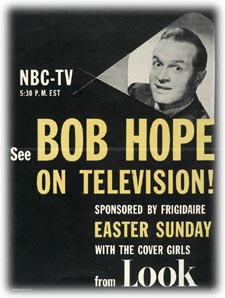 The
variety show was a common format in early television, in part
because many of the performers were vaudevillians with vast
experience performing live on stage, and most early television
was broadcast live. The sale of thousands of television sets
in the late 1940s and early 1950s has been attributed to the
vast popularity of the early TV variety show featuring vaudevillian
Milton Berle. In fact, the popular programs hosted by Berle
and his contemporaries were termed "Vaudeo" by 1950s television
critics. While variety is no longer a prevalent program format,
successors to vaudeville include current television programs
such as The Tonight Show, Saturday Night
Live, and even Sesame Street. The
variety show was a common format in early television, in part
because many of the performers were vaudevillians with vast
experience performing live on stage, and most early television
was broadcast live. The sale of thousands of television sets
in the late 1940s and early 1950s has been attributed to the
vast popularity of the early TV variety show featuring vaudevillian
Milton Berle. In fact, the popular programs hosted by Berle
and his contemporaries were termed "Vaudeo" by 1950s television
critics. While variety is no longer a prevalent program format,
successors to vaudeville include current television programs
such as The Tonight Show, Saturday Night
Live, and even Sesame Street.
Although the National Broadcasting Network (NBC) and Columbia
Broadcasting System (CBS) had been actively experimenting
with television since the 1930s, seven-day-a-week programming
did not begin until 1948. Shows were produced mainly by advertising
agencies on behalf of their sponsor clients, but the networks
were increasingly interested in developing programs as well.
Bob Hope was approached by NBC in 1949 to host his own show
and soon conquered the new medium even as he maintained his
popularity in film and radio.
The Bob Hope Collection at the Library of Congress joins
many important collections which document the entertainment
arts in America. Several of the many great performers and
creators whose collections have been entrusted to the Library
have excelled in variety arts. The collections represented
in the Bob Hope Gallery of American Entertainment include
outstanding television performances rooted in the variety
tradition.
|
|
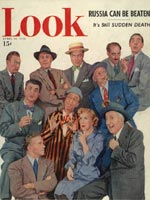
Look Magazine,
April 10, 1951, cover.
Bob Hope Collection,
Motion Picture, Broadcasting
and Recorded Sound Division (123)
|
Look Magazine Tribute to Vaudevillians on Television
Look Magazine paid tribute to the former vaudevillians
who occupied so much of the television schedule in the early
1950s: Top row (l-r): Fred Allen, Jack Benny, Bob Hope,
Groucho Marx, and Eddie Cantor. Middle row: Ken Murray, Ed
Wynn, and Bobby Clark. Bottom row: George Burns, Gracie Allen,
and Jimmy Durante.
|
"Vaudeo" Headlines
Among the words coined by the show business newspaper Variety
is "Vaudeo." Variety used the term in the early 1950s
to refer to variety format television programs that starred
vaudeville veterans such as Milton Berle, Ed Wynn, and Bob
Hope.
|
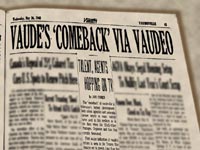
Variety,
May 26, 1948.
General Collections
(125)
|
|
NBC Woos Bob Hope
|
|
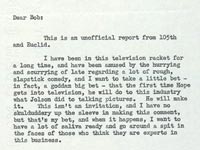
Letter from John Royal to Bob
Hope,
June 29, 1949.
Typed manuscript.
Bob Hope Collection,
Motion Picture, Broadcasting
and Recorded Sound Division (128)
|
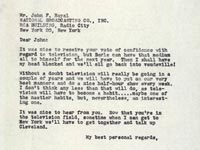
Letter from Bob Hope to John
Royal,
July 13, 1949.
Typed manuscript.
Bob Hope Collection,
Motion Picture, Broadcasting
and Recorded Sound Division (129)
|
|
Given Bob Hope's record of success, it is no surprise that
NBC tried to lure him into television. John Royal was vice
president of the network, and this letter was his first lighthearted
attempt to attract Hope's attention. Although Hope's reply
indicated a willingness to cede the field to fellow vaudevillian
Milton Berle's Texaco Star Theater, within months he would
agree to host his own show.
|
|
Hope's First National Television Appearance
|
|
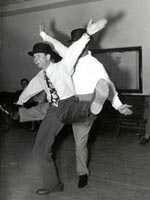
Page from a photo album,
1950.
Page 2
Bob Hope Collection,
Motion Picture, Broadcasting
and Recorded Sound Division (130)
|
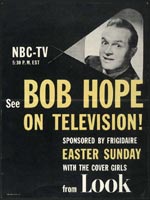
Advertisement for Star Spangled
Revue,
1950.
Bob Hope Collection,
Motion Picture, Broadcasting
and Recorded Sound Division (131)
|
|
Although Hope had presided over television's inaugural West
Coast broadcast in 1947, his NBC debut on April 9, 1950, was
his first national television appearance. He agreed to be
a regular host of Star Spangled Revue, a variety show
produced by Max Liebman. Broadcast live from New York, the
program was much like Hope's radio show-a monologue, skits,
and musical performances
|
|
|
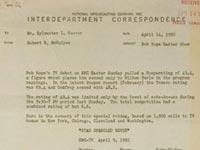
Correspondence from Robert McFaden
to Sylvester Weaver,
April 14, 1950.
Page 2
Typed manuscript.
Bob Hope Collection,
Motion Picture, Broadcasting
and Recorded Sound Division (133)
|
Hope's Early Television Ratings
Hope was an immediate success on television, even as he continued
to star in motion pictures and radio. Within a short time,
his turns as host of Star Spangled Revue were renamed
The Bob Hope Special, which continued as a bi-weekly
staple of NBC's schedule. The last of Hope's 284 television
programs for NBC was in 1997, an unparalleled run of popularity
for a single performer.
|
|
Sid Caesar's Your Show of Shows and Caesar's
Hour
|
|
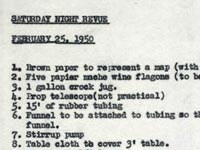
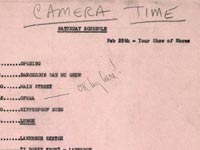 Prop list and
Prop list and
rehearsal sheet for
Your Show of Shows,
February 25, 1950.
Typed manuscript.
Sid Caesar Collection,
Manuscripts Division
(134, 135)
|
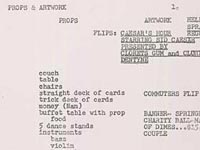
|
"Props
and Artwork" for
Caesar's Hour #43, 1956.
Typewritten manuscript.
Manuscript Division
(135-s1)
|
|
The humor of Sid Caesar's 1950s variety shows, Your Show
of Shows and Caesar's Hour, is among the most
enduring of early television. His popular "Commuters" series
of sketches, which was a recurring feature of Caesar's
Hour, satirized suburban, middle-class, domestic life
much as the contemporary "Honeymooners" skits of Jackie Gleason
offered a comic look at a working-class couple living in the
city.
|
|
Hope on the Tonight Show
|
|
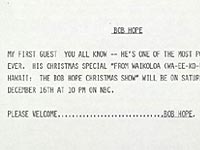
Notecard with Carson's
introduction of Hope on
December 15, 1989, show.
Carson Collection,
Manuscripts Division
(136)
|

Script of The Tonight Show,
December 15, 1989.
Typed manuscript.
Page 2
Carson Collection,
Manuscripts Division
(137)
|
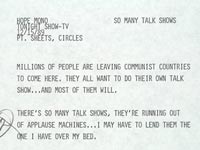 |
Hope
monolog for The Tonight Show,
December 15, 1989.
Typed manuscript, with annotations.
Bob Hope Collection,
Motion Picture, Broadcasting
and Recorded Sound Division (138)
|
|
These production records from the Johnny Carson and Bob Hope
Collections reveal the extensive preparation that went into
Hope's December 15, 1989, Tonight Show appearance. Carson's
staff scripted a list of questions for Hope, while Hope's
staff provided a list of jokes for him to use in response
to Carson's inquiries. The annotation in Hope's hand is a
self-mocking acknowledgment of his reason for being on the
Tonight Show in the first place -- to promote his own special.
|
|
Hope and Carson
Johnny Carson donated The Tonight Show production
records to the Library in 1995, providing valuable insights
into the making of this venerable television institution.
Hope was one of Carson's favorite guests, appearing more than
one hundred times during Carson's thirty-year reign as the
king of late night.
|
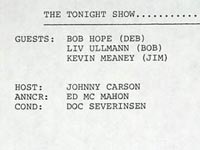
The Tonight Show line-up,
December 15, 1989.
Typed manuscript.
Carson Collection,
Manuscripts Division
(136a)
|
|
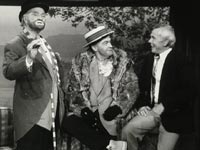
Red Skelton, Bob Hope, and
Johnny Carson on The Tonight Show,
December 21, 1978.
Copyprint.
Bob Hope Collection,
Motion Picture, Broadcasting
and Recorded Sound Division (139)
|
Red Skelton and Bob Hope with Johnny Carson
Bob Hope, dressed as a hobo, and Red Skelton (1913-1997),
playing his well-known character "Freddie the Freeloader,"
chat with Johnny Carson during a December 21, 1978, appearance
on The Tonight Show.
|
Filming Caesar's Hour
The "Commuters" skits on Caesar's Hour regularly
starred Sid Caesar, Carl Reiner, and Howard Morris. An article
in Look magazine went behind the scenes of the production
of the January 16, 1956, Caesar's Hour. Pictured
playing cards during the party are Howard Morris (left) and
Sid Caesar.
|
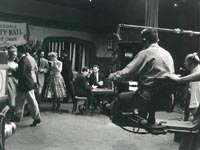
Photograph showing filming of
Caesar's Hour, 1956
Copyprint.
Prints and Photographs
Division (140)
|
|
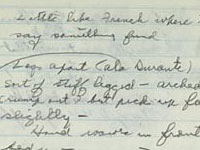
Bob Fosse notebook,
ca. 1970.
Bob Fosse and
Gwen Verdon Collection,
Manuscripts Division
(141)
![Liza with a Z [record album]](images/vc142t.jpg)
Liza with a "Z." Liza Minnelli.
Columbia Records/CBS, 1972.
Courtesy of Columbia Records
Music Division
(142)
|
Bob Fosse Produces Liza with a "Z"
Bob Fosse was one of the musical theater's greatest choreographers
and directors. In 1973, he won the "triple crown" of performing
arts direction: an Oscar for Cabaret, a Tony for Pippin,
and an Emmy for Liza With a "Z." Fosse kept extensive
choreographic notes in a series of simple composition notebooks.
This example-in the Library's Bob Fosse and Gwen Verdon Collection-is
from his television collaboration with Liza Minnelli.
|
Proposal for Liza With a Z, 1971
Bob Fosse's initial concept for Liza With a Z called
for the film to be a documentary of a Liza Minnelli concert
filmed from the perspective of the Ms. Minnelli. However,
the final film, aired September 10, 1972, differed considerably
from this "first draft" of May 1971 and is a more traditional
filmed version of a concert. An excerpt from Liza With
a Z may viewed in the television section of this exhibit.
|
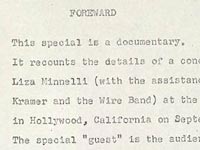
Bob Fosse.
Original concept for Liza With a Z,
May 1971.
Typed manuscript.
Page 2 - Transcript
Bob Fosse and
Gwen Verdon Collection,
Music Division
(143)
|
Bob Hope was one of a handful
of comedians of the latter days of vaudeville who reached
tremendous success in television. These men and women continued
to perform with each other in the television era and conveyed
a great sense of pleasure in doing so. They also inspired
younger entertainers in the variety arts. One of those younger
performers was Johnny Carson who began his career as a magician.
Fan Mail
|
|
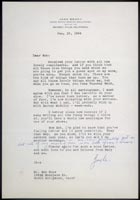
Letter from Jack Benny.
Typewritten manuscript with
holographic emendations,
January 16, 1964.
Bob Hope Collection,
Motion Picture,
Broadcasting and
Recorded Sound Division (145)
|
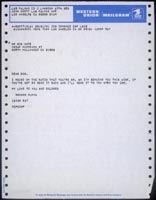
Telegram from George Burns
to Bob Hope.
Telegram, May 21, 1991.
Bob Hope Collection,
Motion Picture,
Broadcasting and
Recorded Sound Division (147)
|
|
|
Letter
from Johnny Carson to Bob Hope.
December 3, 1997.
Holographic manuscript.
Transcript
Copyright Johnny Carson.
Bob Hope Collection,
Motion Picture,
Broadcasting and
Recorded Sound Division (146)
|
|
Correspondence in the Bob Hope Collection includes
many letters and telegrams from fellow entertainers.
They express congratulations on an important occasion,
thank Hope for an opportunity to appear on a broadcast,
declare admiration for his work, or just pass along
a good joke or gag.
|
|
|
|
|
|



